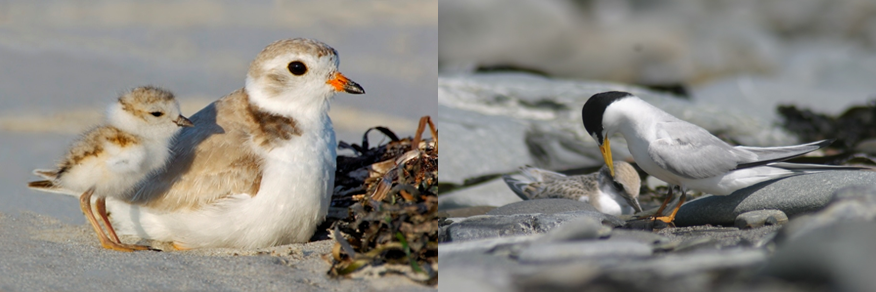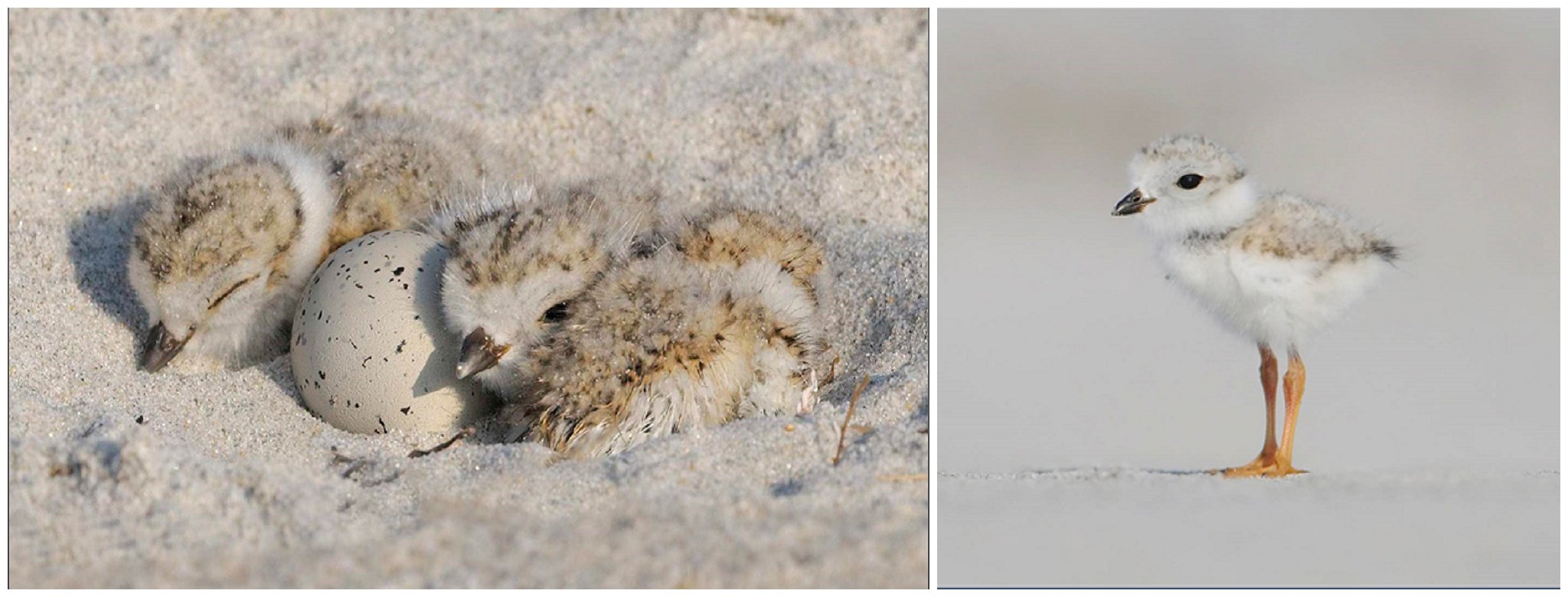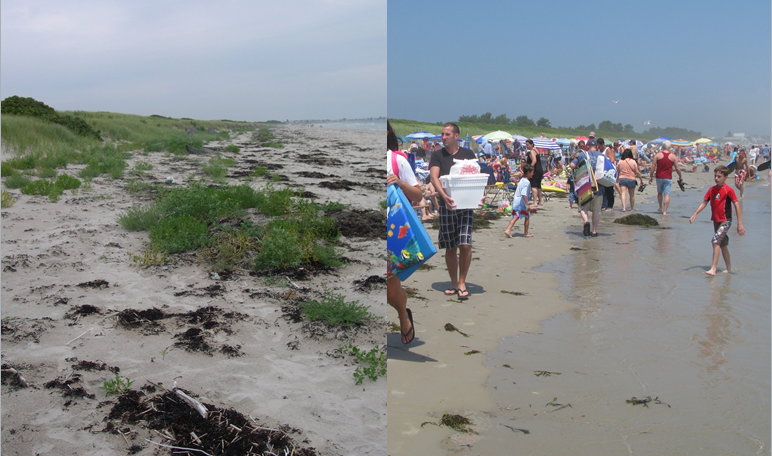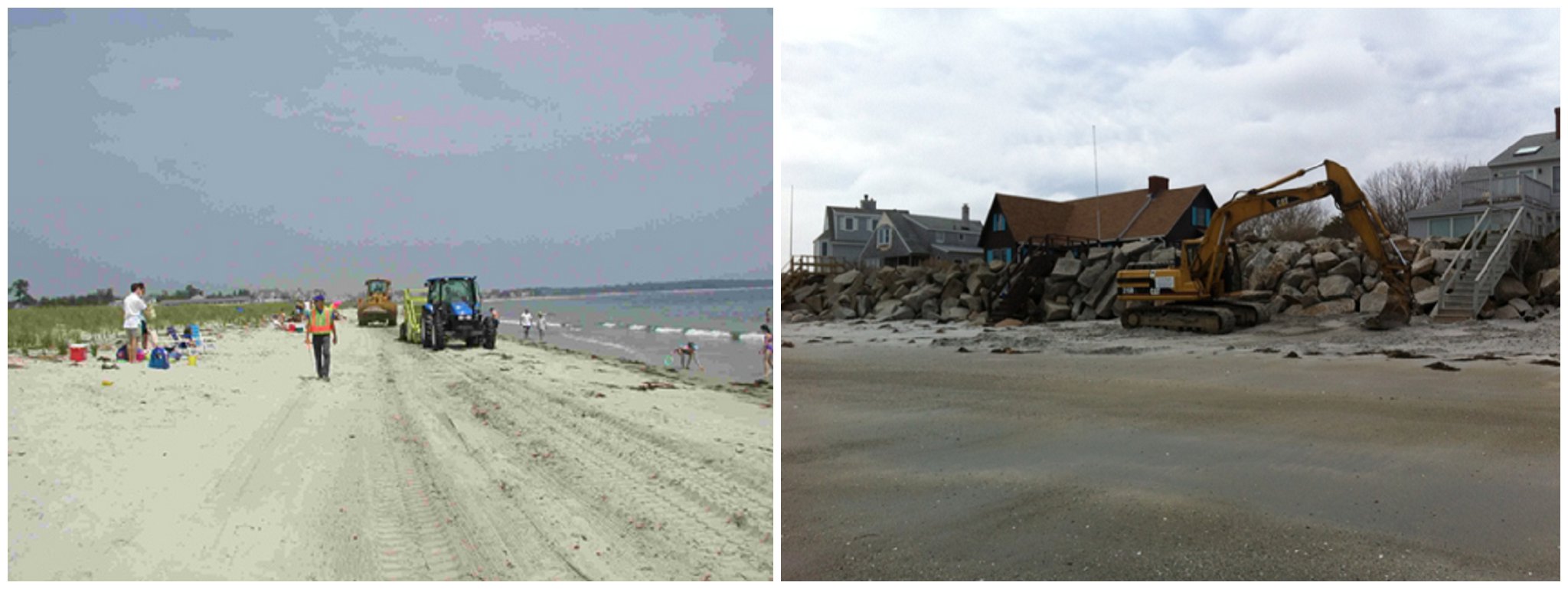June 22, 2016 at 11:58 am
By Assistant Regional Wildlife Biologist Brad Zitske
Piping plovers are small, striking shorebirds typically found on sandy beaches and dunes in southern Maine. Their camouflage plumage makes them more often missed than detected but the keen-eyed observer can see them starting and stopping on the beach in their seemingly endless foraging search for invertebrates. Signs, fenced sections of beaches, and nest exclosures are good indicators of piping plover presence. Least terns are the smallest tern in Maine and are more closely related to gulls than shorebirds. They are aerial foragers seen dive-bombing into the surf trying to catch small fish and making a racket. If terns are swooping precariously close to you on your beach walk, it is a pretty good sign that they have a nesting site nearby. Both species lay eggs directly in shallow depressions on sand beaches along the eastern seaboard and depend on this fragile and dynamic ecosystem for survival.
[caption id="attachment_1591" align="aligncenter" width="789"] Piping plover with chick (left; photo by Jim Fenton) and least tern with chick (right; photo by Eric Hynes).[/caption]
Each spring, piping plovers and least terns return to nest and raise their young on southern Maine beaches. They have a tenuous existence on beaches they share with other wildlife, dogs and people – all factors that affect their ability to survive. Their survival is aided by the strong partnerships of Maine Department of Inland Fisheries and Wildlife, Maine Audubon Society, U.S. Fish and Wildlife Service, USDA Wildlife Services, The Nature Conservancy, Maine Bureau of Parks and Lands, municipalities, volunteers, and private landowners in coastal communities from Ogunquit to Georgetown. All partners serve a vital role in piping plover management in the state while Maine Audubon, in particular, has taken the lead role in actively monitoring piping plovers since 1981 and least terns since 1977.
[caption id="attachment_1596" align="aligncenter" width="799"]
Piping plover with chick (left; photo by Jim Fenton) and least tern with chick (right; photo by Eric Hynes).[/caption]
Each spring, piping plovers and least terns return to nest and raise their young on southern Maine beaches. They have a tenuous existence on beaches they share with other wildlife, dogs and people – all factors that affect their ability to survive. Their survival is aided by the strong partnerships of Maine Department of Inland Fisheries and Wildlife, Maine Audubon Society, U.S. Fish and Wildlife Service, USDA Wildlife Services, The Nature Conservancy, Maine Bureau of Parks and Lands, municipalities, volunteers, and private landowners in coastal communities from Ogunquit to Georgetown. All partners serve a vital role in piping plover management in the state while Maine Audubon, in particular, has taken the lead role in actively monitoring piping plovers since 1981 and least terns since 1977.
[caption id="attachment_1596" align="aligncenter" width="799"] Piping plover chicks hatching – typically four eggs are laid in a shallow depression on sand (left). Chicks can walk and forage on their own within hours of hatching. Young piping plover chick often described as a ‘cotton ball on toothpicks’ (right) relies on cryptic coloration for survival.[/caption]
Historically, Maine had more than 30 miles of suitable nesting beaches that may have supported more than 200 pairs of piping plovers and 1,200 pairs of least terns. However, the construction of seawalls, jetties, piers, homes, parking lots and other structures along sand beaches has reduced the available suitable nesting habitat for these two species by more than 75 percent, resulting in a low population of 6 pairs in 1983. These reasons contributed to listing as endangered species in Maine, meaning they are in imminent danger of disappearing from the State. Today, only about 20 sites (including a section of Higgins Beach in Scarborough owned by MDIFW) provide suitable habitat where the two species nest, feed, and raise their young. Even at these sites, continued development and intense recreational use makes constant monitoring and management a necessity for the long-term viability of these species. With more people and their pets on nesting beaches, adult plovers and terns can be kept from tending to their eggs and chicks, leaving the nests vulnerable to the elements and predators. Outreach and education is a key component to the success of both of these species.
[caption id="attachment_1594" align="aligncenter" width="616"]
Piping plover chicks hatching – typically four eggs are laid in a shallow depression on sand (left). Chicks can walk and forage on their own within hours of hatching. Young piping plover chick often described as a ‘cotton ball on toothpicks’ (right) relies on cryptic coloration for survival.[/caption]
Historically, Maine had more than 30 miles of suitable nesting beaches that may have supported more than 200 pairs of piping plovers and 1,200 pairs of least terns. However, the construction of seawalls, jetties, piers, homes, parking lots and other structures along sand beaches has reduced the available suitable nesting habitat for these two species by more than 75 percent, resulting in a low population of 6 pairs in 1983. These reasons contributed to listing as endangered species in Maine, meaning they are in imminent danger of disappearing from the State. Today, only about 20 sites (including a section of Higgins Beach in Scarborough owned by MDIFW) provide suitable habitat where the two species nest, feed, and raise their young. Even at these sites, continued development and intense recreational use makes constant monitoring and management a necessity for the long-term viability of these species. With more people and their pets on nesting beaches, adult plovers and terns can be kept from tending to their eggs and chicks, leaving the nests vulnerable to the elements and predators. Outreach and education is a key component to the success of both of these species.
[caption id="attachment_1594" align="aligncenter" width="616"] Ogunquit Beach in April when adult piping plovers arrive (left) and in July when adults and chicks face the challenge of co-existing with recreationists (right).[/caption]
One of the tools MDIFW uses to manage the populations of piping plovers and least terns is through the designation of Essential Habitat for these species. Essential Habitats are areas currently or historically providing physical or biological features essential to the conservation of an endangered or threatened species in Maine and which may require special management considerations. Examples of areas that could qualify for designation are nest sites or important feeding areas. For some species, protection of these kinds of habitats is vital to preventing further declines or achieving recovery goals. This habitat protection tool is used only when habitat loss has been identified as a major factor limiting species recovery. Before an area can be designated as Essential Habitat, it must be identified and mapped by MDIFW and adopted through public rulemaking procedures, following Maine's Administrative Procedures Act. Essential Habitat designation requires all projects funded, permitted, and carried out by municipalities and state agencies in mapped areas to be reviewed by MDIFW. This maintains communications with municipalities by allowing biologists to provide guidelines for certain activities prior to development in piping plover and least tern habitats to minimize any adverse impacts in these areas.
[caption id="attachment_1597" align="aligncenter" width="786"]
Ogunquit Beach in April when adult piping plovers arrive (left) and in July when adults and chicks face the challenge of co-existing with recreationists (right).[/caption]
One of the tools MDIFW uses to manage the populations of piping plovers and least terns is through the designation of Essential Habitat for these species. Essential Habitats are areas currently or historically providing physical or biological features essential to the conservation of an endangered or threatened species in Maine and which may require special management considerations. Examples of areas that could qualify for designation are nest sites or important feeding areas. For some species, protection of these kinds of habitats is vital to preventing further declines or achieving recovery goals. This habitat protection tool is used only when habitat loss has been identified as a major factor limiting species recovery. Before an area can be designated as Essential Habitat, it must be identified and mapped by MDIFW and adopted through public rulemaking procedures, following Maine's Administrative Procedures Act. Essential Habitat designation requires all projects funded, permitted, and carried out by municipalities and state agencies in mapped areas to be reviewed by MDIFW. This maintains communications with municipalities by allowing biologists to provide guidelines for certain activities prior to development in piping plover and least tern habitats to minimize any adverse impacts in these areas.
[caption id="attachment_1597" align="aligncenter" width="786"] Essential Habitat designation allows MDIFW biologists to provide input on beach activities that may be detrimental to piping plovers and least terns like beach cleaning (left) and seawall repair (right).[/caption]
In 2015, 121 piping plover chicks fledged (an indicator of success when the birds can fly on their own), more than any other year since monitoring began in 1981. There are currently nearly 70 pairs of piping plovers on Maine beaches and least terns are showing strong numbers as well. These birds are an important part of the natural beauty, heritage and ecology of Maine’s coast and with the dedicated work of MDIFW, its partners, beach communities and visitors we can ensure that endangered wildlife and people can share the beach safely and responsibly to the benefit of all.
Essential Habitat designation allows MDIFW biologists to provide input on beach activities that may be detrimental to piping plovers and least terns like beach cleaning (left) and seawall repair (right).[/caption]
In 2015, 121 piping plover chicks fledged (an indicator of success when the birds can fly on their own), more than any other year since monitoring began in 1981. There are currently nearly 70 pairs of piping plovers on Maine beaches and least terns are showing strong numbers as well. These birds are an important part of the natural beauty, heritage and ecology of Maine’s coast and with the dedicated work of MDIFW, its partners, beach communities and visitors we can ensure that endangered wildlife and people can share the beach safely and responsibly to the benefit of all.

 Piping plover with chick (left; photo by Jim Fenton) and least tern with chick (right; photo by Eric Hynes).[/caption]
Each spring, piping plovers and least terns return to nest and raise their young on southern Maine beaches. They have a tenuous existence on beaches they share with other wildlife, dogs and people – all factors that affect their ability to survive. Their survival is aided by the strong partnerships of Maine Department of Inland Fisheries and Wildlife, Maine Audubon Society, U.S. Fish and Wildlife Service, USDA Wildlife Services, The Nature Conservancy, Maine Bureau of Parks and Lands, municipalities, volunteers, and private landowners in coastal communities from Ogunquit to Georgetown. All partners serve a vital role in piping plover management in the state while Maine Audubon, in particular, has taken the lead role in actively monitoring piping plovers since 1981 and least terns since 1977.
[caption id="attachment_1596" align="aligncenter" width="799"]
Piping plover with chick (left; photo by Jim Fenton) and least tern with chick (right; photo by Eric Hynes).[/caption]
Each spring, piping plovers and least terns return to nest and raise their young on southern Maine beaches. They have a tenuous existence on beaches they share with other wildlife, dogs and people – all factors that affect their ability to survive. Their survival is aided by the strong partnerships of Maine Department of Inland Fisheries and Wildlife, Maine Audubon Society, U.S. Fish and Wildlife Service, USDA Wildlife Services, The Nature Conservancy, Maine Bureau of Parks and Lands, municipalities, volunteers, and private landowners in coastal communities from Ogunquit to Georgetown. All partners serve a vital role in piping plover management in the state while Maine Audubon, in particular, has taken the lead role in actively monitoring piping plovers since 1981 and least terns since 1977.
[caption id="attachment_1596" align="aligncenter" width="799"] Piping plover chicks hatching – typically four eggs are laid in a shallow depression on sand (left). Chicks can walk and forage on their own within hours of hatching. Young piping plover chick often described as a ‘cotton ball on toothpicks’ (right) relies on cryptic coloration for survival.[/caption]
Historically, Maine had more than 30 miles of suitable nesting beaches that may have supported more than 200 pairs of piping plovers and 1,200 pairs of least terns. However, the construction of seawalls, jetties, piers, homes, parking lots and other structures along sand beaches has reduced the available suitable nesting habitat for these two species by more than 75 percent, resulting in a low population of 6 pairs in 1983. These reasons contributed to listing as endangered species in Maine, meaning they are in imminent danger of disappearing from the State. Today, only about 20 sites (including a section of Higgins Beach in Scarborough owned by MDIFW) provide suitable habitat where the two species nest, feed, and raise their young. Even at these sites, continued development and intense recreational use makes constant monitoring and management a necessity for the long-term viability of these species. With more people and their pets on nesting beaches, adult plovers and terns can be kept from tending to their eggs and chicks, leaving the nests vulnerable to the elements and predators. Outreach and education is a key component to the success of both of these species.
[caption id="attachment_1594" align="aligncenter" width="616"]
Piping plover chicks hatching – typically four eggs are laid in a shallow depression on sand (left). Chicks can walk and forage on their own within hours of hatching. Young piping plover chick often described as a ‘cotton ball on toothpicks’ (right) relies on cryptic coloration for survival.[/caption]
Historically, Maine had more than 30 miles of suitable nesting beaches that may have supported more than 200 pairs of piping plovers and 1,200 pairs of least terns. However, the construction of seawalls, jetties, piers, homes, parking lots and other structures along sand beaches has reduced the available suitable nesting habitat for these two species by more than 75 percent, resulting in a low population of 6 pairs in 1983. These reasons contributed to listing as endangered species in Maine, meaning they are in imminent danger of disappearing from the State. Today, only about 20 sites (including a section of Higgins Beach in Scarborough owned by MDIFW) provide suitable habitat where the two species nest, feed, and raise their young. Even at these sites, continued development and intense recreational use makes constant monitoring and management a necessity for the long-term viability of these species. With more people and their pets on nesting beaches, adult plovers and terns can be kept from tending to their eggs and chicks, leaving the nests vulnerable to the elements and predators. Outreach and education is a key component to the success of both of these species.
[caption id="attachment_1594" align="aligncenter" width="616"] Ogunquit Beach in April when adult piping plovers arrive (left) and in July when adults and chicks face the challenge of co-existing with recreationists (right).[/caption]
One of the tools MDIFW uses to manage the populations of piping plovers and least terns is through the designation of Essential Habitat for these species. Essential Habitats are areas currently or historically providing physical or biological features essential to the conservation of an endangered or threatened species in Maine and which may require special management considerations. Examples of areas that could qualify for designation are nest sites or important feeding areas. For some species, protection of these kinds of habitats is vital to preventing further declines or achieving recovery goals. This habitat protection tool is used only when habitat loss has been identified as a major factor limiting species recovery. Before an area can be designated as Essential Habitat, it must be identified and mapped by MDIFW and adopted through public rulemaking procedures, following Maine's Administrative Procedures Act. Essential Habitat designation requires all projects funded, permitted, and carried out by municipalities and state agencies in mapped areas to be reviewed by MDIFW. This maintains communications with municipalities by allowing biologists to provide guidelines for certain activities prior to development in piping plover and least tern habitats to minimize any adverse impacts in these areas.
[caption id="attachment_1597" align="aligncenter" width="786"]
Ogunquit Beach in April when adult piping plovers arrive (left) and in July when adults and chicks face the challenge of co-existing with recreationists (right).[/caption]
One of the tools MDIFW uses to manage the populations of piping plovers and least terns is through the designation of Essential Habitat for these species. Essential Habitats are areas currently or historically providing physical or biological features essential to the conservation of an endangered or threatened species in Maine and which may require special management considerations. Examples of areas that could qualify for designation are nest sites or important feeding areas. For some species, protection of these kinds of habitats is vital to preventing further declines or achieving recovery goals. This habitat protection tool is used only when habitat loss has been identified as a major factor limiting species recovery. Before an area can be designated as Essential Habitat, it must be identified and mapped by MDIFW and adopted through public rulemaking procedures, following Maine's Administrative Procedures Act. Essential Habitat designation requires all projects funded, permitted, and carried out by municipalities and state agencies in mapped areas to be reviewed by MDIFW. This maintains communications with municipalities by allowing biologists to provide guidelines for certain activities prior to development in piping plover and least tern habitats to minimize any adverse impacts in these areas.
[caption id="attachment_1597" align="aligncenter" width="786"] Essential Habitat designation allows MDIFW biologists to provide input on beach activities that may be detrimental to piping plovers and least terns like beach cleaning (left) and seawall repair (right).[/caption]
In 2015, 121 piping plover chicks fledged (an indicator of success when the birds can fly on their own), more than any other year since monitoring began in 1981. There are currently nearly 70 pairs of piping plovers on Maine beaches and least terns are showing strong numbers as well. These birds are an important part of the natural beauty, heritage and ecology of Maine’s coast and with the dedicated work of MDIFW, its partners, beach communities and visitors we can ensure that endangered wildlife and people can share the beach safely and responsibly to the benefit of all.
Essential Habitat designation allows MDIFW biologists to provide input on beach activities that may be detrimental to piping plovers and least terns like beach cleaning (left) and seawall repair (right).[/caption]
In 2015, 121 piping plover chicks fledged (an indicator of success when the birds can fly on their own), more than any other year since monitoring began in 1981. There are currently nearly 70 pairs of piping plovers on Maine beaches and least terns are showing strong numbers as well. These birds are an important part of the natural beauty, heritage and ecology of Maine’s coast and with the dedicated work of MDIFW, its partners, beach communities and visitors we can ensure that endangered wildlife and people can share the beach safely and responsibly to the benefit of all.

Categories